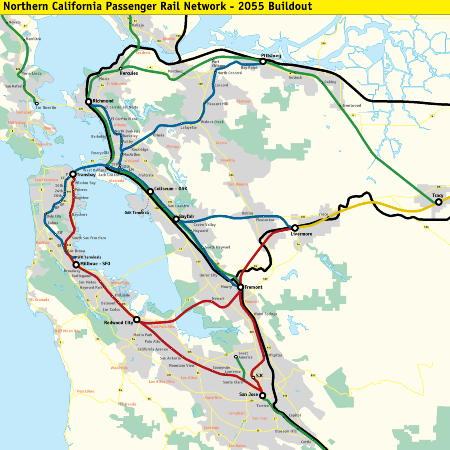
Possible Regional Rail Network - 2055
click for larger version
Bay Area Regional Rail Plan
| The Regional Rail Plan
for the Bay Area will develop a vision for the region's rail network in
the year 2055. These pages hope to outline the optimal system and
describe the rationale behind the design. It is hoped that the network described here
will beomce one of the final alternatives in the MTC's study. MTC describes the project as follows: MTC is conducting the study in cooperation with the California High Speed Rail Authority (CHSRA), San Francisco Bay Area Rapid Transit District (BART), and the Peninsula Corridor Joint Powers Board (Caltrain). The Regional Rail Plan includes two main study elements. The first element is a Regional Rail Plan that integrates passenger rail systems, improves interfaces with connecting services, expands the regional rapid transit network, and coordinates public investments in regional rail systems with transit-supportive land uses. The second element is an alternatives analysis of various California high-speed rail alignments between the Central Valley and the Bay Area. This analysis will be used to inform the CHSRA’s planned EIR/EIS for high-speed rail alignments between the Central Valley and Bay Area. These two elements are to be integrated in order to provide a fully comprehensive Bay Area Regional Rail Plan. The scope of the plan considers both freight and passenger traffic. It includes conventional rail, BART, future high-speed rail and emerging diesel light rail technologies, popular elsewhere in the world for years. More information on the MTC study can be found at: www.bayrailplan.info Architecture 21's Goal Too often in the Bay Area, the systems we have built do not connect. We have also limited ourselves to either conventional rail (Caltrain, ACE....) or BART solutions, often ignoring the synergy possible with integration. This plan looks to make connections, and build out a network that spans the entire region. BART Extensions Three key BART extensions are envisioned in the plan. One runs from the end of the Pittsburg-BayPoint line to a new terminal in Pittsburg that will be shared with the Contra Costa-Delta rail corridor. The second extends the Dublin-Pleasanton line into central Livermore to connect with the regional and intercity high speed rail line to the Central Valley. The third extension brings the Fremont line to a new terminal on the east side of Fremont Central Park to meet the new high speed rail line. If desired, the full extension to San Jose can be built, but the connection between the high speed rail and BART would be made at the planned Warm Springs station and only link to the San Jose HSR line. On the map, the BART system is shown in blue. Passenger Rail Lines The railway regulations in the United States have developed around freight transport issues, not passenger service. This makes sense at a national level, but severely constrains the modernization and efficient operation of passenger service, especially in metropolitan areas. This plan assumes that federal regulations will develop that allow the adoption of rules based on optimal passenger operations, utilizing the safety practices that have been developed elsewhere in the world over the past 60 years. This includes the use of commonly available railway equipment that is lighter and faster than currently allowed under federal regulations. The lines in this group would not all be freight-free, but freight service would be tightly controlled to stay clear of passenger service, to the benefit of both safety and operations. The lines between the peninsula and San Jose through Fremont to Livermore and on to the Central Valley would be freight free. They are new construction and will be built with gradients and tunnels that preclude shared usage with freight trains. The pacesetter for this portion of the network will be Caltrain, between San Francisco and San Jose. Building off this will be:
Demand would dictate the electrification of some of the passenger lines. It is assumed that the Caltrain line and the Redwood City-Livermore line, along with the San Jose-Fremont lines would electrified, as they would also serve as part of the state's high speed rail network, but the other lines could be operated by quick non-electrified multiple unit vehicles. All electrified portions of the line will also be utilized by statewide high speed passenger trains. The Passenger Lines are shown in red or green on the map. Red signifies electrified lines, green is not electrified. The high speed rail connection into the Central Valley is gold. Freight Lines Freight traffic is growing rapidly, driven by the growth at the Port of Oakland. Planning for added capacity from the port to points outside the Bay Area is a key component of the study. To improve freight and passenger operations, the traffic needs to be separated onto their own tracks. This will be accomplished by merging UPRR and BNSF service onto the UPRR line between Port Chicago and the Port of Oakland. Between Richmond, the Port of Oakland and San Leandro, the ROW will also host separate facilities for passenger service. This portion of the UPRR will be completely grade-separated (with the possible exception of Jack London Square). To bypass downtown San Jose, the existing UPRR line to the east of downtown will be rebuilt and key crossings will be grade separated. Improvements will also be made to the UPRR line through the Amador Valley in conjunction with the construction of the high speed rail line. Freight will still be able to operate on the Passenger lines, but the operation will be overseen by the entity operating the passenger service utilizing locomotives with the appropriate signaling and safety technology. Freight lines are shown in black. |
